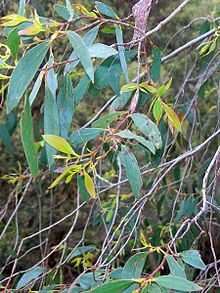Eucalyptus stellulata
| Black Sallee | |
|---|---|
 | |
| Sub-parallel leaf venation of Eucalyptus stellulata | |
| Scientific classification | |
| Kingdom: | Plantae |
| (unranked): | Angiosperms |
| (unranked): | Eudicots |
| (unranked): | Rosids |
| Order: | Myrtales |
| Family: | Myrtaceae |
| Genus: | Eucalyptus |
| Species: | E. stellulata |
| Binomial name | |
| Eucalyptus stellulata Sieber ex DC. | |
Eucalyptus stellulata, commonly known as Black Sallee or Black Sally, is a high altitude tree found in south-eastern Australia. The species was described in 1828, in Prodromus Systematis Naturalis Regni Vegetabilis, authored by Swiss botanist Augustin Pyramus de Candolle. The specific epithet stellulata ("star-shaped") refers to the appearance of the clustered flower buds.
Description
Black Sallee is small to medium sized tree, up to 15 m in height. The bark is dark and rough at the base. About halfway up the tree, the bark sheds revealing smooth branches, of a yellowish olive green, somewhat oily to the touch. The juvenile leaves are opposite on the stem, round and stalk-less. Mature leaves are 50 to 90 mm long, 13 to 25 mm wide, lanceolate to egg shaped. The leaves are the same shade of green above and below. The leaf veins are almost parallel and glossy.[1] The flower buds form between April and October. The fruits are stalkless, cup shaped or truncate-globose, around 5 mm in diameter, with three enclosed valves.[2]
Distribution and habitat
Black Sallee occurs from near the border of New South Wales and Queensland, southwards along the Great Dividing Range to the eastern highland Victoria. It is a common plant in grassy eucalyptus woodland, often near swamps and by streams. The soils are usually of a relatively good fertility.
References
- ↑ "Eucalyptus stellulata". PlantNET - NSW Flora Online. Retrieved October 5, 2010.
- ↑ A Field Guide to Eucalypts - Brooker & Kleinig volume 1, ISBN 0-909605-62-9 page 108